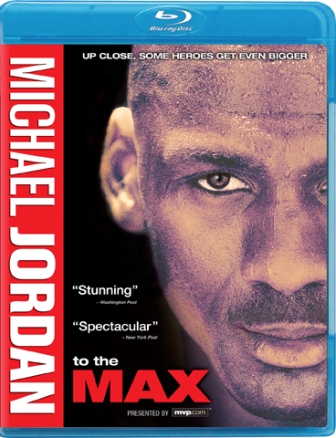CHICAGO – In anticipation of the scariest week of the year, HollywoodChicago.com launches its 2024 Movie Gifts series, which will suggest DVDs and collections for holiday giving.
Blu-Ray Review: ‘Michael Jordan to the Max’ Recommended For Bulls Fans Only
CHICAGO – With all the depth and nuance of a Nike commercial, “Michael Jordan to the Max” probes into the mind of its titular subject, a man as infamous for his astonishing achievements in basketball as he is for his spectacular success as a corporate spokesperson. This 46-minute feature is not about Jordan the person, but Jordan the marketable icon: family man, mentor, role model, eternal optimist.
For someone who grew up in Chicagoland during the six unforgettable championship triumphs of the Chicago Bulls, any footage of Jordan from the 1990s is guaranteed to evoke nostalgic memories. Yet this once popular, decade-old IMAX picture appears to have been made primarily for elementary school field trips. There’s very little substance to be gleaned from Jordan’s inspirational soundbites, and writer/editor Jonathan Hock’s workmanlike assemblage of game highlights.
 Blu-Ray Rating: 3.0/5.0 |
Viewed today, “Max” instantly dates itself with a trendy swirling pan around an airborne Jordan, clearly modeled after the groundbreaking effects work in 1999’s “The Matrix.” No home theater equipment could possibly equal the experience of viewing this footage on an eight-story screen with surround sound. Yet any self-respecting Bulls fan will undoubtedly leap at the chance to view segments from the Bulls’ historic 1998 season in razor-sharp High Definition. After its flashy opening, the film settles into a routine documentary structure, juxtaposing Jordan’s rise to fame with the final games leading up to his retirement from the Bulls. It’s striking to recall just how close the competition was between the Bulls and the Utah Jazz in the final days of the series, and how heartbreaking it was to see Jordan lose his final United Center game. And it’s still hugely thrilling to see Jordan score the final basket that ultimately defeated the Jazz on their home turf. These larger than life moments alone make the film warrant a viewing.

Michael Jordan is larger than life in Don Kempf and James D. Stern’s Michael Jordan to the Max.
Photo credit: Lionsgate Entertainment
At its worst, “Max” plays like bad reality TV, with manufactured suspense and glib talking heads. Narrator Laurence Fishburne struggles mightily to inject tangible tension into the final act, as John Debney’s intrusive score swells. Coach Phil Jackson, “Hang Time” author Bob Greene and Jordan’s mother Deloris are among the interviewees who pop up in small squares on the screen that probably made sense when viewed in IMAX, but here seem like a built-in picture-in-picture commentary. Conspicuously missing from the interviews are fellow Bulls players, with the exception of Steve Kerr (I suspect Scottie Pippen would’ve brought especially great insight into the psyche of Jordan). After earning the most laughs in Jordan’s 1996 kiddie vehicle, “Space Jam,” Bill Murray once again steals the show in an uncredited cameo where he attempts to wow the audience with his IMAX-sized bowl of popcorn. Though the film amounts to little more than a celebratory novelty, it does offer a few moments of genuine poignance, such as when Jordan remembers how he had envisioned his late father joining him on daily trips to the baseball field during his audacious yet misguided break from basketball.
 Michael Jordan to the Max was released on Blu-Ray on March 1, 2011. Photo credit: Lionsgate Entertainment |
“Michael Jordan to the Max” is presented in 1080p High Definition (with a 1.85:1 aspect ratio), and includes a list of Jordan’s complete stats from 1984 through 1998. There’s also a 21-minute making-of featurette, the majority of which is devoted to the film’s obvious money shot: the 270 degree camera move around Jordan as he soars through the air before landing a slam dunk. “Matrix” visual effects designer John Gaeta discusses the painstaking process of filming a “bullet time” effect, while explaining how it allows action to be slowed and examined. It’s interesting to observe just how hyped this effect was before it became instantly commonplace. The United Center backdrop was convincingly superimposed behind Jordan on a green screen, while a multitude of cameras were lined up in a row to capture every inch of his movement toward the basket (an additional effects breakdown also reveals the sequence’s various evolutionary stages). This was one of the first “bullet time” shots to literally revolve around a “dynamically moving subject,” allowing the filmmakers to explore the limitless possibilities of “virtual cinematography” achievable only through computer planning.
Meanwhile, directors Don Kempf and James D. Stern spend much of the time gushing over their star, cheerfully outing themselves as biased Jordan fans. Kempf and Stern share a commentary track with producer Steve Kempf in which they reminisce about the admittedly amazing experience of viewing Jordan’s final championship season with the Bulls from a courtside perch. Cinematographers staggered the shooting of each game, utilizing three cameras to avoid missing any highlights during mag changes. They also made sure to position their lenses far enough away from a given subject, resulting in shots that never caused an IMAX audience to feel trapped within the up-close-and-personal pores of a player. Yet this approach renders the footage unremarkable on a small screen. And since the directors didn’t want to “pepper the film with too much archival footage,” highlights from Jordan’s career are often shoved into the corners of the frame. For a film with an eight-story-tall subject, “Max” certainly knows how to keep its distance.
 | By MATT FAGERHOLM |


